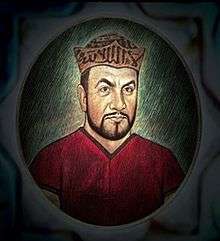Sa'd al-Din Köpek
Sa’d al-Din Köpek (Arabic: سعد الدين كوبك بن محمد, Sa’d al-Dīn Kobek bin Muhammad; Turkish: Sadettin Köpek, d. 1240) was a court administrator under two 13th century Seljuq Sultans of Rum, and is known for his indirect role in the subjugation of the Sultanate of Rum by the Mongol Empire due to his disloyalty and aim for greater power during the turbulent 13th century in Anatolia.

He served as Master of the Hunt and Minister of Works under Kayqubad I and, after in the latter capacity, supervised the construction of Kubadabad Palace on the shore of Lake Beyşehir.[1]
Biography
Köpek, as an advisor to Kayqubad's successor Kaykhusraw II, grew his influence considerably. His first aim was to secure the reign of the new sultan. He had Kaykhusraw's two half-brothers strangled along with their mother, an Ayyubid princess, but he did not became successful and was later killed by Ertuğrul, some sources indicate he was hanged on the Seljuk palace walls for treason. It was also known that he wanted throne of Seljuqs and had made his connections with Mongols. He suspected the loyalty of the Khwarezmians, the remnant followers of Jalal al-Din Manguberti whom Kayqubad had installed in various Anatolian fortresses, and had their leader, a certain Kirkhan, imprisoned. The Khwarezmians abandoned their posts and fled to Diyar Mudar, where they applied to the Ayyubids for work as mercenaries. Köpek's suspicion deprived the sultanate of seasoned soldiers at a time of external threat and internal instability.

A caravanserai built by Sa’d al-Din Köpek during 1235-1237[2] survives about 22 kilometres (14 mi) from Konya on the road to Aksaray.[3] Known as Zazadin Han, the caravanserai bears two inscriptions: one naming Köpek as founder and dated 1235-36, the other indicating the patronage of both Kayqubad I and Kaykhusraw II.[2]
Popular Culture
In the Turkish Televsion Series, Diriliş: Ertuğrul, Sa’d al-Din Köpek is portrayed by Turkish Actor Murat Garipağaoğlu. In the series, Sa’d al-Din Köpek's name is in Turkish, as Sadettin Köpek, and is shown as a traitor and is eventually killed by the protagonist, Ertuğrul.
References
- H. Crane "Notes on Saldjūq Architectural Patronage in Thirteenth Century Anatolia," Journal of the Economic and Social History of the Orient, v. 36, n. 1 (1993), p. 43.
- "The Seljuk Han of Anatolia—Zazadin Han". turkishhan.org. Retrieved 30 July 2020.
- Dogan, Abdullah (9 August 2019). "Turkey: Ancient caravansary opens doors to tourism". aa.com.tr. Anadolu Agency. Retrieved 30 July 2020.
Sources
- Claude Cahen, Pre-Ottoman Turkey: A general survey of the material and spiritual culture and history c. 1071-1330 (Taplinger: New York 1968), 133-34.
- Carole Hillenbrand, “Sa’d al-Dīn Köpek b. Muhammad” Encyclopaedia of Islam, ed. by P. Bearman, et al. (Brill 2007).